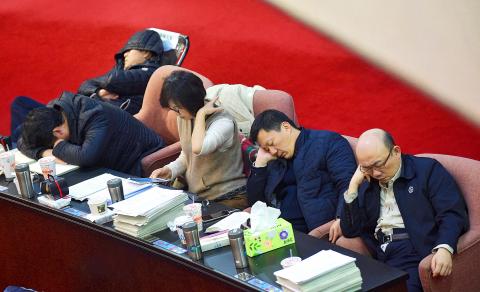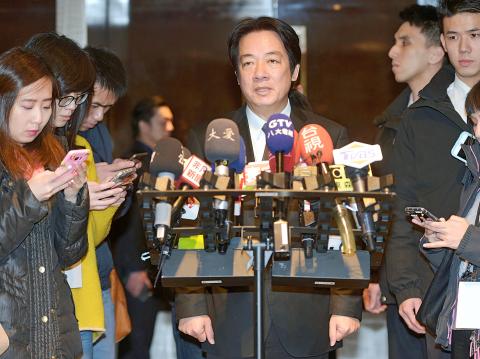Controversial amendments to the Labor Standards Act (勞動基準法) yesterday cleared the legislature, with President Tsai Ing-wen (蔡英文) apologizing for the inconvenience caused by her administration’s two revisions of the act within a year.
Under the amended act, overtime pay is to remain at least 1.33 times a worker’s normal hourly wage for the first two hours and at least 1.66 times from the third hour onward on weekdays.
The rates are to remain at 2.33 and 2.66 times a worker’s normal rates if they are asked to work on their weekly “flexible” day off.

Photo: Liu Hsin-de, Taipei Times
However, workers would no longer be paid overtime in blocks of four hours, but by the actual number of hours they work.
Employers are allowed to raise the monthly overtime cap from 46 to 54 hours after gaining the consent of unions or their employees during employer-staff meetings and notifying the local labor authorities, with the proviso that employees must not be allowed to work more than 138 hours in three months.
Employees would also have the option of converting their overtime into compensatory leave, but if they are unable to use the compensatory in an agreed period of time or before their contract expires, their employer would be required to convert it back into an overtime payment.

Photo: Chang Chia-ming, Taipei Times
The amended act stipulates that employees can roll unused annual leave over to the next year and that employers should convert remaining annual leave days into wages at the end of the second year.
Employers would be allowed to move an employee’s fixed weekly day off within a period of 14 days with the prerequisite that they have gained the approval of unions or employees.
Sectors wishing to adopt the measure would need to pass a review by the local authority and be designated by the Ministry of Labor as a sector that qualifies.
The aforementioned provisos also apply to an amendment that allows employers in approved sectors to shorten the rest time between shifts from 11 to eight hours.
The amendments are to take effect on March 1.
Following the bill being passed at 8:44am, Tsai issued a formal apology to the public for the social unrest caused by the second amendment to the act in a year.
While Premier William Lai (賴清德) has already apologized, Tsai said she felt she owed the public an apology as the head of her administration.
Tsai also thanked police for their hard work due to the protests the amendment provoked.
The controversy surrounding the bill, while causing some turmoil, nonetheless shows that Taiwan is a society willing to accommodate a plurality of opinions, she said.
The act would benefit employers and employees alike, and offer a substantial foundation for industrial transition, she said.
Chinese Nationalist Party (KMT) legislators apologized to workers nationwide over their failure to block the bill.
“We would like to apologize to more than 9 million workers nationwide. Despite our greatest efforts, we were unable to stop the Labor Standards Act from being sabotaged,” KMT caucus secretary-general Lin Wei-chou (林為洲) said.
“We could only do so much, but we truly hope that we can return to power in this year’s local elections and achieve what the central government could not,” KMT Legislator Chen Yi-ming said.

The US government has signed defense cooperation agreements with Japan and the Philippines to boost the deterrence capabilities of countries in the first island chain, a report by the National Security Bureau (NSB) showed. The main countries on the first island chain include the two nations and Taiwan. The bureau is to present the report at a meeting of the legislature’s Foreign Affairs and National Defense Committee tomorrow. The US military has deployed Typhon missile systems to Japan’s Yamaguchi Prefecture and Zambales province in the Philippines during their joint military exercises. It has also installed NMESIS anti-ship systems in Japan’s Okinawa

‘WIN-WIN’: The Philippines, and central and eastern European countries are important potential drone cooperation partners, Minister of Foreign Affairs Lin Chia-lung said Minister of Foreign Affairs Lin Chia-lung (林佳龍) in an interview published yesterday confirmed that there are joint ventures between Taiwan and Poland in the drone industry. Lin made the remark in an exclusive interview with the Chinese-language Liberty Times (the Taipei Times’ sister paper). The government-backed Taiwan Excellence Drone International Business Opportunities Alliance and the Polish Chamber of Unmanned Systems on Wednesday last week signed a memorandum of understanding in Poland to develop a “non-China” supply chain for drones and work together on key technologies. Asked if Taiwan prioritized Poland among central and eastern European countries in drone collaboration, Lin

NO CONFIDENCE MOTION? The premier said that being toppled by the legislature for defending the Constitution would be a democratic badge of honor for him Premier Cho Jung-tai (卓榮泰) yesterday announced that the Cabinet would not countersign the amendments to the local revenue-sharing law passed by the Legislative Yuan last month. Cho said the decision not to countersign the amendments to the Act Governing the Allocation of Government Revenues and Expenditures (財政收支劃分法) was made in accordance with the Constitution. “The decision aims to safeguard our Constitution,” he said. The Constitution stipulates the president shall, in accordance with law, promulgate laws and issue mandates with the countersignature of the head of the Executive Yuan, or with the countersignatures of both the head of the Executive Yuan and ministers or

CABINET APPROVAL: People seeking assisted reproduction must be assessed to determine whether they would be adequate parents, the planned changes say Proposed amendments to the Assisted Reproduction Act (人工生殖法) advanced yesterday by the Executive Yuan would grant married lesbian couples and single women access to legal assisted reproductive services. The proposed revisions are “based on the fundamental principle of respecting women’s reproductive autonomy,” Cabinet spokesperson Michelle Lee (李慧芝) quoted Vice Premier Cheng Li-chiun (鄭麗君), who presided over a Cabinet meeting earlier yesterday, as saying at the briefing. The draft amendment would be submitted to the legislature for review. The Ministry of Health and Welfare, which proposed the amendments, said that experts on children’s rights, gender equality, law and medicine attended cross-disciplinary meetings, adding that